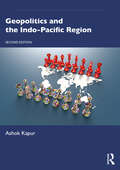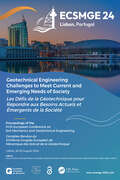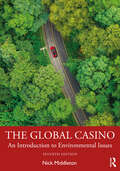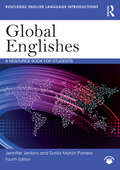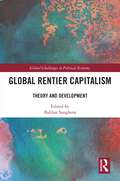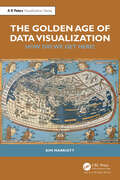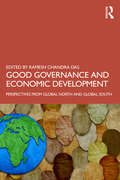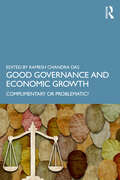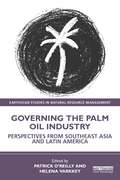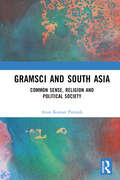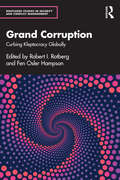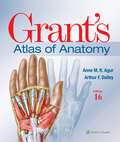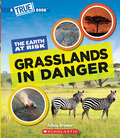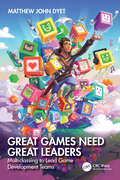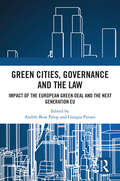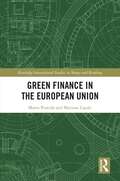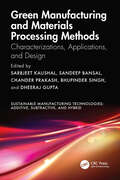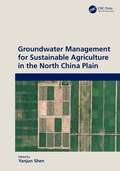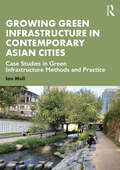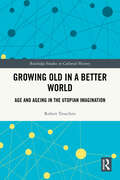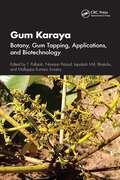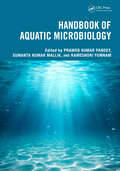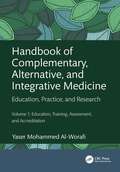- Table View
- List View
Geopolitics and the Indo-Pacific Region
by Ashok KapurExploring geopolitics of the Indo-Pacific Region, a major hub of global, economic, commercial, military, diplomatic, and cultural activities in the 21st century, this textbook provides students with an introduction to the existing debates, frameworks, and issues surrounding the Indo-Pacific.The second edition has been revised, updated, and expanded to explain the major build-up of deterrence hubs during 2022–2023 in the Indo-Pacific Region (IPR). The hubs have a clear focus on North Asia (Japan and South Korea), the Taiwan Strait and Taiwan and the South China Sea (the Philippines, Vietnam, and Australia), and India and the Indian Ocean littoral areas (the Persian Gulf and the Bay of Bengal). This edition takes into account the effects of the Ukraine–Russia and Israel–Hamas/Iran proxies’ conflicts on the build-up of Russia–China–North Korea–Iran ties and the naval projections by China and Russia in North Pacific, off the Alaska coast, and in relation to Myanmar and Bangladesh and the Gulf/Red Sea areas. Within the purview of maritime security and NATO, the present century is critical with the introduction of missiles and nuclear submarine technology into IPR and by the fragmentation of arms control and nuclear and missile non-proliferation arrangements of the 1960s–2000 period. This volume predicts that China’s oft-proclaimed rise to global hegemonic status is not inevitable because of its many economic–social problems and foreign policy dilemmas. Nor is World War III inevitable because no one seeks unlimited warfare, but the regions in conflict will likely remain on a low boil. However, problem-solving and crisis resolution will remain problematic, keeping the 21st century at its toes, due to the inability of regional powers to unite for the common good.Complete with a list of further reading, Geopolitics and the Indo-Pacific Region fills a gap in the market and will be of great interest to upper-year-level undergraduates, postgraduate students, and researchers studying international relations, IPR geopolitics, Asian politics, and Asian security studies.
Geotechnical Engineering Challenges to Meet Current and Emerging Needs of Society
by Nuno Guerra‘Geotechnical Engineering Challenges to Meet Current and Emerging Needs of Society’ includes the papers presented at the XVIII European Conference on Soil Mechanics and Geotechnical Engineering (Lisbon, Portugal, August 26 to 30th, 2024). The papers aim to contribute to a better understanding of problems and solutions of geotechnical nature, as well as to a more adequate management of natural resources. Case studies are included to better disseminate the success and failure of Geotechnical Engineering practice. The peer-reviewed articles of these proceedings address the six main topics: New developments on structural design Geohazards Risk analysis and safety evaluation Current and new construction methods Environment, water, and energy Future city world vision With contributions from academic researchers and industry practitioners from Europe and abroad, this collection of conference articles features an interesting and wide-ranging combination of innovation, emerging technologies and case histories, and will be of interest to academics and professionals in Soil Mechanics and Geotechnical Engineering.
Gewinnen in der Plattform-Ökonomie: Der Leitfaden für Handelsentscheider
by Alexander GrafDas Buch von Alexander Graf verarbeitet die aktuellen Entwicklungen der E-Commerce-Branche. Plattformen wie Amazon, TEMU, Trendyol usw. haben die Regeln komplett neu- und umgeschrieben. Was 2020 noch "gut" war, lockt 2024 keinen Kunden mehr in den Onlineshop. Das Buch schaut sich die neuen Regeln genau an und bewertet diverse Spieler in diesem Markt nach diesen neuen Regeln. Es beantwortet Fragen wie: Was kommt nach Zalando? Wo geht die Reise mit Amazon hin? Warum ist TEMU so erfolgreich? Das Buch ist sehr gut lesbar für E-Commerce-Entscheider. Der Autor selbst arbeitet seit 20 Jahren in der Branche auf Entscheiderebene und weiß, wie man mit und für die Zielgruppe kommuniziert. Es ist kein theoretisches Werk, sondern spricht ganz klar die Herausforderungen der Industrie an. Case Studies bezogen auf den deutschsprachigen Markt runden den Praxisbezug des Buches ab.
The Global Casino: An Introduction to Environmental Issues
by Nick MiddletonThe Global Casino is an introduction to environmental issues which deals both with the workings of the physical environment and the political, economic and social frameworks in which the issues occur. Using examples from all over the world, the book highlights the underlying causes behind environmental problems, the human actions which have made them issues and the hopes for solutions. It is a book about the human impact on the environment and the ways in which the natural environment impacts human society.The seventh edition has been fully revised and updated throughout, with new case studies, figures and online resources comprising a complete lecture course for tutors and multiple-choice questions for students. New concepts and topics covered for the first time in this edition include the blue economy, marine heatwaves, Africa’s Great Green Wall, rewilding, net-zero commitments, nature-based solutions, emerging contaminants in global rivers, green infrastructure in sustainable cities, initiatives promoting zero-emission vehicles, and zoonotic diseases (including the COVID-19 pandemic). New case studies include gender impact assessment of big dams in Laos and Vietnam, reducing food loss and waste, liming sugar maple trees in North America to counteract soil acidification and soil erosion and poverty in Rwanda. Eighteen chapters on key issues follow three initial chapters which outline the background contexts of the physical and human environments and the concept of sustainable development. Each chapter provides historical context for key issues, outlines why they have arisen and highlights areas of controversy and uncertainty to appraise how issues can be resolved both technically and in political and economic frameworks. Each chapter also contains an updated critical guide to further reading—most of them open access—and websites, talks and podcasts, as well as discussion points and essay questions. The text can be read in its entirety or individual chapters adopted as standalone reading.This book is an essential resource for students of the environment, geography, development studies and earth sciences. It provides comprehensive and inspirational coverage of all the major global environmental issues of the day in a style that is clear, concise and critical.
Global Englishes: A Resource Book for Students (Routledge English Language Introductions)
by Jennifer Jenkins Sonia Morán PaneroRoutledge English Language Introductions cover core areas of language study and are one-stop resources for students. Assuming no prior knowledge, books in the series offer an accessible overview of the subject, with activities, study questions, sample analyses, and commentaries.Global Englishes, Fourth Edition has been fully revised and updated and provides an introduction to the subject that is both accessible and comprehensive.Key features of this best-selling textbook include:• coverage of the major historical, linguistic, and sociopolitical developments in the English language from the start of the seventeenth century to the present day;• exploration of the current debates in Global Englishes, relating to its uses as a post-colonial language in Asia and Africa, a mother tongue in the US, UK, and Antipodes, and lingua franca across the globe, with a strong emphasis on China;• new material on Latin America, English as a lingua franca, and English medium instruction;• a range of texts, data, and examples drawn from emails, tweets, and newspapers;• readings from key scholars including Alastair Pennycook, Henry Widdowson, and Lesley Milroy;• updated online support material providing additional materials that are closely linked to each unit of the book.Global Englishes, Fourth Edition provides a dynamic and engaging introduction to this fascinating topic and is essential reading for all students studying global Englishes more broadly, English as a Lingua Franca specifically, and the factors involved in the spread of English in the world today.
Global Rentier Capitalism: Theory and Development (Global Challenges in Political Economy)
by Balihar SangheraRecent work on rent and rentierism has offered a distinctive and fresh approach to understanding and explaining contemporary capitalism. Drawing on political economy, economics, geography and sociology, this research has brought together distinct theoretical traditions in original and fertile ways to reshape the study of issues related to class, political-economic change and environmental challenges.This book critically engages with these theoretical resources to analyse and evaluate economies in the Global North and South. It offers historical, theoretical and empirical accounts of rentierism, making important cross-disciplinary and global connections. Its four parts address global rentier capitalism under the headings of historical lessons, theoretical developments and empirical studies of rentierism in the Global North and South. It will be the first book of its kind to offer a global account of rentier capitalism.It will be of immense interest to readers in economics, political economy, sociology, geography and development studies.
The Golden Age of Data Visualization: How Did We Get Here?
by Kim MarriottWe are living in the Golden Age of Data Visualization. The COVID-19 pandemic has demonstrated how we increasingly use data visualizations to make sense of the world. Business analysts fill their presentations with charts, journalists use infographics to engage their readers, we rely on the dials and gauges on our household appliances, and we use mapping apps on our smartphones to find our way.This book explains how and why this has happened. It details the evolution of information graphics, the kinds of graphics at the core of data visualization—maps, diagrams, charts, scientific and medical images—from prehistory to the present day. It explains how the cultural context, production and presentation technologies, and data availability have shaped the history of data visualization. It considers the perceptual and cognitive reasons why data visualization is so effective and explores the little-known world of tactile graphics—raised-line drawings used by people who are blind. The book also investigates the way visualization has shaped our modern world. The European Renaissance and the Scientific Revolution relied on maps and technical and scientific drawings, and graphics influence how we think about abstract concepts like time and social connection.This book is written for data visualization researchers and professionals and anyone interested in data visualization and the way we use graphics to understand and think about the world.
Good Governance and Economic Development: Perspectives from Global North and Global South
by Ramesh Chandra DasGood governance is a prerequisite to development, improving the quality of life, and health and ensuring equity. This book examines the interdependency of good governance and economic development by exploring perspectives from the Global North and the Global South.It assesses the impact of good governance on economic development of countries such as the USA, India, Nigeria, Turkey, Pakistan, Bangladesh, Nepal and others, and on groups of developing nations like BRICS or ASEAN. The book investigates the interrelationships between development indicators like education, health, gender equity, resource distribution, environmental preservation, quality of life, livelihood and others with governance and provides empirical verifications of the impact of good governance upon development. Further, it offers insights into the economic and governance challenges that developing countries face and highlights strategies for governance that have proved effective in bolstering sustainable growth.This volume will be of interest to students and researchers of economics, political science, social science, international relations, public administration and sociology.
Good Governance and Economic Growth: Complimentary or Problematic?
by Ramesh Chandra DasGovernance has been incorporated into the development models of many countries because of its role in ameliorating inequalities in society. This book explores whether good governance boosts or hinders economic growth with perspectives from countries like India, the USA, Nigeria, Turkey, Pakistan, Bangladesh, Nepal, and others, and on groups of developing nations like BRICS and ASEAN.Governance has twin roles within economic systems. The first is where it guides administrators and the second is the normative role where it may act as a stimulus to economic growth and development. With the help of empirical investigations, this book analyses the interrelationships between good governance and inclusive and sustainable economic growth, productive employment, political stability, and decent work for all. It assesses the impact of various governance indicators and policy strategies on the economy and the GDP of countries in the Global North and South. The book also focuses on roadblocks to good governance such as violent conflicts, corruption, international threats and crises and its implication on economic growth. This volume will be of interest to students and researchers of economics, political science, social science, international relations, public administration, and sociology.
Governing the Palm Oil Industry: Perspectives from Southeast Asia and Latin America (ISSN)
by Helena Varkkey Patrick O’ReillyThis book examines how different countries across Southeast Asia and Latin America respond to the emergence and expansion of the lucrative, yet controversial palm oil industry, paying attention to how national policy and governance regimes are shaping this global industry.With its historic roots in Southeast Asia, oil palm cultivation continues to expand beyond its historical centres. In Latin America, many countries are now developing their own policies to promote and govern oil palm cultivation. This book provides a unique examination of how different countries strive to strike a balance between developmental and environmental concerns, through case studies on Indonesia, Malaysia, the Philippines, Thailand, Colombia, Brazil, Ecuador, Honduras, and Mexico, and an outlook for the industry's prospects in Africa. This book applies an assemblage approach to draw out lessons on the global challenges posed by the industry and how differing national governance regimes and communities might respond to them. Rather than a single global industry, the book unveils a complex arrangement of national and even local palm oil assemblages, indicating that there is more than one way to do palm oil. In doing so, the book contributes to a better understanding of the drivers and processes that shape the governance of the industry, both in different nations and globally.This book will be of great interest to students and scholars of the palm oil industry, as well as those interested in natural resource governance, sustainable agriculture, conservation, environmental justice, and environmental and development policy more broadly.
Gramsci and South Asia: Common Sense, Religion and Political Society
by Arun Kumar PatnaikGramsci’s theory of common sense is a metanarrative that can be used to explain both religion and political formations. This book examines Gramsci’s perspective and how his theories translate into South Asian society. It explores Gramsci’s historicism, which is sensitive to historical, regional and national differences, and its relevance in post-colonial societies.The volume discusses themes like common sense, religious common sense, folk religion, dialogue and common sense concerning civil/political society through the lens of Gramsci’s historical perspectives. It also looks at Gramscian critique of political secularism, the ideology and politics of Hindutva, civil society in a non-Western context and modes of political society in India.Lucid and topical, this book is a must-read for scholars and researchers of political studies, political philosophy, post-colonial studies, South Asian politics, cultural studies and political sociology.
Grand Corruption: Curbing Kleptocracy Globally (Routledge Studies in Security and Conflict Management)
by Robert I. Rotberg Fen Osler HampsonThis book examines the nature, causes, and consequences of grand corruption, showing how it can be assessed, measured, and attacked from within and without.The volume brings together in a single, definitive text some of the best analyses on how to measure the costs of grand corruption and dissects the legal approaches and institutions to counter grand corruption and kleptocracy. Through a series of compelling country case studies, the book explores how corrupt political elites and public officials have stolen from the public purse for personal gain at the expense of their own people and their country’s social and economic development. It also highlights the role of financial and legal intermediaries in the West in laundering these ill-gotten gains. The volume then explores the impact of existing legal constraints on controlling corruption, some of which are still in the evolutionary stage of development. It draws lessons from different national attempts to control corruption as well as regional and international initiatives. The final section of the volume discusses a variety of new anti-corruption initiatives, including efforts to establish an International Anti-Corruption Court.This book will be of much interest to students of grand corruption, global governance, foreign policy, international law, and international relations.
Grant's Atlas of Anatomy
by Anne M. R. Agur Arthur F. Dalley IIFor more than 75 years, Grant’s Atlas of Anatomy has maintained a tradition of excellence while continually adapting to meet the needs of each generation of students. The updated 16th edition is a visually stunning reference that delivers the accuracy, pedagogy, and clinical relevance expected of this classic atlas, with new and enhanced features that make it even more practical and user-friendly. Illustrations drawn from real specimens, presented in surface-to-deep dissection sequence, set this book-only version of Grant’s Atlas of Anatomy apart as the most accurate reference available for learning human anatomy. These realistic representations bring structures to life and provide students with the ultimate lab resource.
Grasslands in Danger (A True Book (Relaunch))
by Felicia BrowerDiscover the rich biodiversity of Earth's biomes - and how they might be saved - with this STEAM-based subset of True Books.Did you know that grasslands cover 25 percent of Earth's surface? They are also being destroyed at an alarming rate! Get ready to investigate tropical and temperate grasslands around the globe, as well as the plants and animals that have adapted to survive on them. You'll also learn about the many threats facing this fascinating biome-and what each of us can do to help-all in the pages of Grasslands in Danger.ABOUT THE SERIES:There are five major biomes on Earth: desert, forest, grassland, aquatic, and tundra. These rich, wild places are home to a wide variety of plants and animals - many of which are found nowhere else. Unfortunately, these ecosystems have been put at risk by human activities. This STEAM-based set of True Books introduces students to the incredible biodiversity of Earth's amazing biomes, as well as the threats they face in the era of climate change. Interesting information is presented in a fun, friendly way - and in the simplest terms possible - and will inspire kids to think about how they can help stop the destruction of Earth's wild spaces.
Great Games Need Great Leaders: Multiclassing to Lead Game Development Teams
by Matthew John DyetThis book brings together the knowledge and perspectives of numerous past and present games industry leaders and practitioners to form a clear picture of how leadership operates in a game development studio. It identifies the ways in which things are changing or can change for the better in the games industry and provides a set of tools for the reader to use in their own professional practice.Embark on a journey with this book to understand how great leaders help make great games. These leaders embrace change through a broad set of skills intended to empower and nurture the teams they find themselves responsible for. Through the lens of three fantasy roleplaying classes – the Warrior, the Bard, and the Cleric – readers will understand the wide variety of skills and considerations involved in leading game developers well.This book will be of great interest to anybody curious about or currently working in games development.
Green Cities, Governance and the Law: Impact of the European Green Deal and the Next Generation EU
by Andrés Boix Palop and Giorgia PavaniThis book focusses on the developing role that the city currently plays in dealing with the effects of climate change and the instruments that can be utilised to make them truly green. Cities are at the centre of European directives aimed at tackling climate change, representing a key part of the European Green Deal and the National Recovery and Resilience Plans. As such, they provide valuable case studies for other countries grappling with how to address sustainability issues. This book is divided into three parts, with the first analysing Green urban planning and local governments in the European framework. The second examines various thematic aspects relating to this intersection, looking at the National Recovery and Resilience Plans, the right of the city and environmental issues. The third and final part presents case studies from four European cities showing how they are facing this transformation. These include Bologna, Paris, Barcelona and Valencia, each chosen by the Mission climate-neutral and smart cities by 2030. Bringing together leading experts, some of whom have been directly involved in developments, the book presents invaluable comparisons that will be of interest to a wider international readership. The book will be of interest to academics, researchers and policymakers working in the areas of Public Law, Environmental Law, Urban Law and Governance.
Green Finance in the European Union (Routledge International Studies in Money and Banking)
by Marta Postuła Mariusz LipskiWhile global challenges continue to reshape the here and now, public and corporate finance management needs to adapt quickly to increase the efficiency of institutions, enterprises and policies to face our new reality. There are very few publications that offer a comprehensive approach to the financing of environmental protection activities by the European Union. This book explores this topic from various angles and levels, as well as highlighting the determinants that influence micro- and macro-level decisions in this area.It presents an in-depth and unique analysis of the sources of funding for environmental measures implemented by European Union institutions, against the backdrop of national expenditure by Member States, and analyses the plausibility of the adopted targets in the run-up to 2050, in the context of the war in Ukraine and ad hoc energy policy solutions. This book is a voice in an ongoing discussion among the community of practitioners and theoreticians on sources of financing for the energy transition to achieve independence from Russian sources in the quickest possible timeframe. It demonstrates that environmental measures cannot occur without the financial participation of economic actors and financial institutions, particularly the capital market, and further underscores the scale of involvement in environmental projects, as measured by the value of green loans and green bonds covered by European financial institutions. The authors offer policy recommendations for financing activities related to environmental policy, notably energy transition.This book will appeal to scholars, students and researchers of corporate finance, banking, strategic and public finance management as well as polic-ymakers and practitioners involved in green finance investments.
Green Manufacturing and Materials Processing Methods: Characterizations, Applications, and Design (Sustainable Manufacturing Technologies)
by Bhupinder Singh Chander Prakash Sarbjeet Kaushal Sandeep BansalIn this modern technological era, conserving and making better use of resources like energy, water, and other essential resources have recently been one of the main concerns for the manufacturing industry. To successfully compete against the competition, industries are replacing outdated manufacturing techniques with cutting-edge ones that are sustainable in terms of cost, energy usage, better product quality, and environmental safety. Green manufacturing has become one of the key priorities for attaining this.Green Manufacturing and Materials Processing Methods: Characterizations, Applications, and Design offers a critical review of the past work done in green manufacturing and material processing technologies. It presents recent research and development that is going on currently with green manufacturing techniques and discusses characterizations, applications, and the design aspect of materials processed through green manufacturing technologies. With a focus on the sustainability aspect, this book showcases new breakthroughs and comparisons of cutting-edge sustainable manufacturing and materials processing with currently available conventional methods. Highlights throughout the book are on improvements used in various manufacturing processes such as casting, joining, drilling, surface engineering, sintering, and composite manufacturing.This book will serve as a first-hand information source for academic researchers and industrial firms. With the help of this book, readers will have a unique opportunity to comprehend and evaluate recent advancements in green manufacturing and material processing technology. This book will be the go-to resource for individuals who desire to do research or development in the area of sustainable manufacturing and material processing technologies.
Groundwater Management for Sustainable Agriculture in the North China Plain
by Yanjun ShenThis book is a unique text that explores recent research on the management of sustainable groundwater use in the North China Plain (NCP), where aquifers are suffering the most severe over‑pumping in the world and have caused serious ecological degradation. It contains research conducted by the editor and his teams on several projects over the past 18 years.Key topics covered include: comprehensive scheme and pathways to achieve sustainable groundwater management description of theoretical basis for water saving and technologies developed in practice at field scale adjusting cropping patterns and planting structure to reduce the cultivation intensity to a suitable extent soft measures such as water metering, pricing, and water marketing being applied in groundwater management practice in the NCP. It will be an invaluable resource to graduate students, education and research staff, and agriculture or water resources authorities.
Growing Green Infrastructure in Contemporary Asian Cities: Case Studies in Green Infrastructure Methods and Practice
by Ian MellGrowing Green Infrastructure in Contemporary Asian Cities examines to what extent green infrastructure (GI) is being implemented in East and Southeast Asian cities. The book reflects upon the integration of contemporary approaches to landscape planning alongside traditional forms of green space design and cultural understandings of the landscape in China, Hong Kong, Japan, Singapore, and South Korea. Working from a multi-locational perspective, the book illustrates how political, socio-cultural, economic, and ecological factors influence the delivery of GI and the consequences of these decisions. The book provides a set of best practice recommendations for the design, development, and management of greener urban areas. It both explains how GI is being utilised in East and Southeast Asia to address climate change, promote economic prosperity, and support the development of more livable places, and identifies future trends in its use. It is a key resource for any practitioners, students, and academics working in landscape planning and green infrastructure in an Asian context.
Growing Old in a Better World: Age and Ageing in the Utopian Imagination (Routledge Studies in Cultural History)
by Robert TroschitzAs utopias question social ills and express human wants and unfulfilled dreams, they offer insights into the problems, desires and ideals of a certain time. This book uses this lens to examine cultural representations of ageing and old age in utopian writings from the Renaissance till today.The individual chapters offer detailed analyses and interpretations of numerous utopias from Thomas More’s Utopia (1516) to contemporary science fiction. Through close readings, the book explores age-related fears and ideals and investigates how perceptions of ageing and the life course as well as attitudes towards older people have developed over the centuries. Covering a large time span and a broad range of different utopias, the book identifies long-term developments and also puts certain dreams such as that of ever-lasting youth into a wider perspective. It thus enriches both our understanding of the cultural history of ageing and the history of utopian thought.The book will appeal to scholars and students from the fields of cultural gerontology and utopian studies, as well as literary studies and cultural history more generally.
Gum Karaya: Botany, Gum Tapping, Applications, and Biotechnology
by Mallappa Kumara Swamy T. Pullaiah Lepakshi Md. Bhakshu Niranjan PrasadPolysaccharide gums have a wide range of applications due to their hydrophilic properties. They have been used as a gelling agent, encapsulating agent, thickener, emulsifier, and stabilizer. Sourcing natural gums from botanical and plant sources has become an important focus in producing acceptable food ingredients in liquids and semi-solid forms. This is mainly because of the positive attitude of consumers toward plant-based gums rather than other gums from animal and microbial sources.Gum karaya, also known as Indian tragacanth, is a vegetable gum produced as an exudate by trees of the genus Sterculia. Gum karaya has very strong swelling properties, high viscosity, and very poor solubility because of its acetyl groups. Therefore, it is mainly used in cosmetics and pharmaceuticals. Gum karaya is one of the least-soluble gums used for many industries, such as petroleum and gas, textile, paper and pulp, leather and allied products, ammunition and explosives, electrical appliances, adhesives, confectionery, medicine, pharmaceuticals, and cosmetics.Because of the crude tapping method and overexploitation, the population of karaya trees has markedly declined. In the absence of cultivation of this tree on the regular plantation, there is grave concern about the loss of wild germplasm of S. aurens. As gum karaya is vital for the tribal economy and its trade value is substantial, there is a pressing need to develop a scientific and sustainable tapping method to increase the yield and ensure the survival of the tapped trees. There is also a need for a large-scale plantation of gum karaya. People are becoming health-conscious and are taking natural products as food ingredients. This book will be useful to all the people interested in natural food additives. This book gives the details of gum karaya–yielding species and their distribution. Scientific methods of gum tapping are given for sustainable gum production. Propagation methods, both field and in vitro, are given. Uses of gum karaya, in cosmetics, pharmaceuticals, and food, are given. Genetic diversity and biotechnological intervention for the improvement of gum karaya–yielding species are included. Threats and conservation of gum karaya–yielding species are given.
Handbook of Aquatic Microbiology
by Pramod Kumar Pandey, Sumanta Kumar Mallik, and Rameshori YumnamShort Blurb This handbook covers the different aspects of the aquatic environment, microbiology, and microbial applications. It highlights the role of microorganisms as pollution indicators and as bio-control agents. The book covers the impact of pollution on microorganisms, biofilms, cyanobacterial blooms, and the metagenomics approach to isolate microbes. Standard Blurb This comprehensive handbook covers the different aspects of the aquatic environment, microbiology, and microbial applications. The world’s aquatic environment is facing a serious threat due to inappropriate planning, implementation, and management. This book compiles effective strategies for managing the aquatic environment. It highlights the role of microorganisms as pollution indicators, in bioremediation, and as bio-control agents. The book also covers the impact of pollution on microorganisms, biofilms, cyanobacterial blooms, and the metagenomics approach to isolate microbes. This book is essential for students and researchers of microbiology, environmental sciences, and biotechnology Seasonal Blurb This comprehensive handbook covers the different aspects of the aquatic environment, microbiology, and microbial applications. The world’s aquatic environment is facing a serious threat due to inappropriate planning, implementation, and management. This book compiles effective strategies for managing the aquatic environment. It highlights the role of microorganisms as pollution indicators, in bioremediation, and as bio-control agents. The book also covers the impact of pollution on microorganisms, biofilms, cyanobacterial blooms, and the metagenomics approach to isolate microbes. This book is essential for students and researchers of Microbiology, Environmental Sciences, and Biotechnology. 1 Includes key themes like environmental DNA application, metagenomes, extremophiles, microbial population genetics and statistical aspects of aquatic microbiology 2 Discusses the beneficial microbes of the aquatic environment 3 Covers applications of microbes in bioremediation, as pollution indicators and as algicidal agents 4 Reviews freshwater biogeochemical cycles and sediment microbiology 5 Explores microbial communities of biofloc and microbiomes in aquaponics
Handbook of Complementary, Alternative, and Integrative Medicine: Education, Practice, and Research Volume 1: Education, Training, Assessment, and Accreditation
by Yaser Mohammed Al-WorafiVolume 1 focuses on complementary, alternative, and integrative medicine (CAM) education. Its 20 chapters cover CAM education history, needed competencies, and curriculum reform, among other topics. It is Volume 1 of 6 that describe the education, practice and research related issues and the efficacy and safety of CAM in treating various conditions. The purpose of these six volumes (sold individually or as a set) is to explain how complementary, alternative, and integrative medicine is practiced around the world; to share the best practice/experiences in terms of education, practice and research; and identify the challenges and suggest recommendations to overcome the identified challenges.Key Features: Addresses worldwide issues of education, training, assessment, and accreditation in complementary and alternative medicine Deals with such hot topics as access/equitable access, online education, and quality and accreditation Serves as part of a six-volume comprehensive treatment of complementary, alternative, and integrative medicine as practiced around the world
Handbook of Intelligent and Sustainable Manufacturing: Tools, Principles, and Strategies (Advancements in Intelligent and Sustainable Technologies and Systems)
by Yang Liu Rakesh Kumar Ajay Kumar Parveen KumarIntelligent and sustainable manufacturing is a broad category of manufacturing that employs computer-integrated manufacturing, high levels of adaptability and rapid design changes, digital information technology, and more flexible technical workforce training. Other goals sometimes include fast changes in production levels based on demand, optimization of the production system, efficient production, and recyclability. This handbook provides compiled knowledge of intelligent and sustainable manufacturing within the context of Industry 4.0. along with tools, principles, and strategies.Handbook of Intelligent and Sustainable Manufacturing: Tools, Principles, and Strategies offers recent developments, future outlooks, and advanced and analytical modeling techniques of intelligent and sustainable manufacturing with examples backed up by experimental and numerical data. It bridges the gap between R&D in intelligent and sustainable manufacturing–related fields and presents case studies and solutions alongside social and green environmental impact. The handbook includes a wide range of advanced tools and applications with modeling results and explains how different internet technologies integrate the manufacturing approach with people, products, and complex systems. By encompassing advanced technologies such as digital twins, big data informatics, artificial intelligence, nature-inspired algorithms, IoT, Industry 4.0, simulation approaches, analytical strategies, quality tools, roots and pillars, diagnostic tools, and methodical strategies, this handbook provides the most up-to-date and advanced information source available.This handbook will help industries and organizations to implement intelligent manufacturing and move towards the sustainability of manufacturing practices. It will also serve as a reference for senior graduate-level courses in mechanical, production, industrial, and aerospace engineering and a value-added asset to libraries of all technical institutions.
